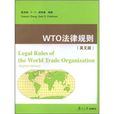《WTO法律規則》既考慮了世界貿易組織(WTO)概論課程的特點,又努力滿足WTO法律規則與實務課程的需要,試圖找到介紹WTO概況與探討其法律制度的某種平衡,因此是一個探討和嘗試。
基本介紹
- 書名:WTO法律規則
- ISBN:9787309062908
- 出版社:復旦大學出版社
- 開本:16
版權資訊
編輯推薦
內容簡介
作者簡介
Gary D. Patterson,J.D, Western State University College of Law at Fullerton, Professor, California State University at San Bernardino, Adjunct Professor, University of California at Riverside
圖書目錄
1.1 The Theory of Comparative Advantage
1.1.1 Basics of the Theory
1.1.2 Historical Overview
1.1.3 David Ricardos Numerical Example
1.1.4 The Ricardian Model Assumptions and Results
1.2 The Theory of Market Economy
1.2.1 Spontaneous Order or “Invisible Hand”
1.2.2 Free Market Economy
1.2.3 Government Intervention
1.2.4 Criticism of Market Economy
1.3 The Theory of Sustainable Development
1.3.1 Scope and Definitions
1.3.2 History of Sustainable Development as a Policy Concept
1.3.3 The Earth Summit and Environmental Sustainability
1.3.4 WTO and Sustainable Development
CASE STUDY
CS 1.1 True Meaning and Intuition of the Theory of Comparative Advantage
CS 1.2 Chinas Market Economy Status(MES)
Chapter Two Development of the WTO
Chapter Two Development of the WTO
2.1 Basics of the WTO
2.1.1 The WTO in Brief
2.1.2 The Multilateral Trading System
2.1.3 The GATT Years: from Havana to Marrakesh
2.2 Development of the WTO
2.2.1 The 1947 GATT Agreement
2.2.2 GATT Multilateral Trade Negotiation Meetings
2.2.3 Uruguay Round and the World Trade Organization
2.3 The Organization of the WTO
2.3.1 Introduction to WTO Organization
2.3.2 WTO Organization Chart
2.3.3 Membership, Alliances and Bureaucracy
2.3.4 The Secretariat Chart
2.3.5 Special Policies
2.4 China and WTO
2.4.1 Chinas WTO Entry
2.4.2 The Right-and-Duty Balance in the WTO
CASE STUDY
CS 2.1 Doha Development Round
Chapter Three Basic Principles of the WTO
3.1 Reciprocity
3.1.1 Two Folds of Reciprocity
3.1.2 WTO Rules of Reciprocity
3.1.3 Theoretical Interpretation of Reciprocity
3.2 Non-discrimination
3.2.1 Most-favoured-nation (MFN)
3.2.2 National Treatment: Treating Foreigners and Locals Equally
3.3 Liberalization of Trade
3.3.1 Liberalization for Goods
3.3.2 Liberalization for Services
3.3.3 Limits to Liberalization
3.4 Transparency
3.4.1 Introduction to Transparency
3.4.2 Publication and Administration of Trade Regulations
3.4.3 Transparency Rules for GATS
3.4.4 Transparency Rules for TRIPS
3.4.5 Trade Policy Review Mechanism ( "TPRM" )
CASE STUDY
CS 3.1 MFN Exception: Promotion of Regional Intergration-Custom Unions
CS 3.2 National Treatment
Chapter Four Trade in Goods
4.1 Basics of Trade in Goods
4.1.1 GATT 1994
4.1.2 Interpretation of GATT 1994 Articles
4.1.3 Basic Principles of the GATT 1947/1994
4.2 Tariff Concessions
4.2.1 Tariffs: More Bindings and Closer to Zero
4.2.2 Tariff Cuts
4.2.3 More Bindings
4.2.4 Tariffs and Agriculture
4.3 Non-tariff Measures
4.3.1 Standards and Safety
4.3.2 Import Licensing: Keeping Procedures Clear
4.3.3 Rules for the Naluation of Goods at Customs
4.3.4 Preshipment Inspection: a Further Check on Imports
4.3.5 Rules of Origin
4.3.6 Investment Measures: Reducing Trade Distortions
4.4 Trade in Specific Products
4.4.1 Textiles and Clothing
4.4.2 Information Technology Agreement
CASE STUDY
CS 4.1 Sanitary and Phytosanitary Measures
CS 4.2 Safeguard
Chapter Five Agriculture Agreement
5.1 Basics of Trade in Agriculture
5.1.1 New Rules
5.1.2 Market Access
5.1.3 Domestic Support
5.1. 4 Export Subsidies: Limits on Spending and Quantities
5.1.5 The Least-developed and Those Depending on Food Imports
5.2 Understanding the Agriculture Agreement
5.2.1 Introduction
5.2.2 Market Access
5.2.3 Domestic Support
5.2.4 Export Competition/Subsidies
5.2.5 Other Issues
5.2.6 Net Food-Importing Developing Countries
5.2.7 Summary
5.3 The Agriculture Negotiations
5.3.1 The Doha Mandate
5.3.2 The Current Negotiations
CASE STUDY
CS 5.1 Japan-Import Quotas on Dried Laver and Seasoned Laver (DS323)
CS 5.2 European Communities-Protection of Trademarks and Geographical Indications for Agricultural Products and Foodstuffs (DS174, 290)
Chapter Six Trade Remedy Measures
6.1 Safeguards
6.1.1 Safeguards: Emergency Actions for Imports of Particular Products
Chapter Seven Trade in Services
Chapter Eighe Intellectual Property Rights
Chapter Nine Otheer New Issues of the WTO
Chapter Ten Procedural Rules of the WTO
Annex Ⅰ Agreement Establishing the World Trade Organization
Annex Ⅱ Protocol on the Accession of the Peoples Republic 0f China
Bibliography

